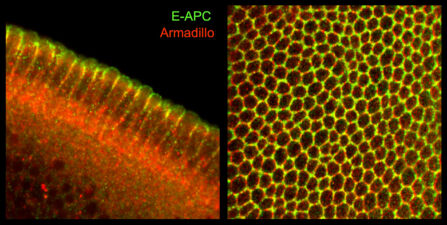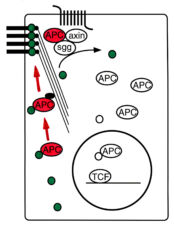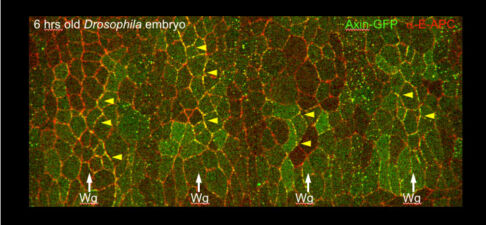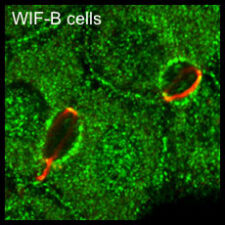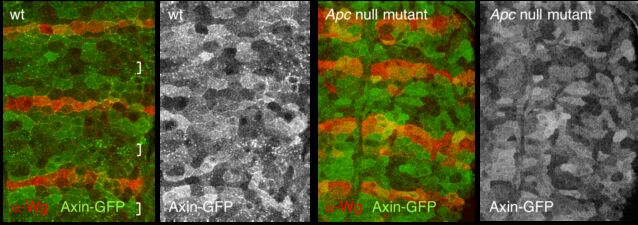Our yeast two-hybrid screen based on activated Armadillo led us to discover a second Drosophila APC paralogue as an Armadillo-binding protein, which we called E-APC owing to its expressed in epithelia and association with E-cadherin and Armadillo at adherens junctions. E-APC (aka dAPC2) functions as an essential negative regulator of Armadillo, redundantly with its paralogue dAPC1 as shown by the Peifer group. Our evidence from flies and human epithelial cell models indicated that E-APC and its human counterpart, the APC tumour suppressor, promote shuttling of Armadillo/beta-catenin along actin filaments between the nuclear signalling and the cell adhesion pool. An interesting corollary is that APC proteins, like their Armadillo/beta-catenin binding partners, have dual functions in Wnt signalling and cellular adhesion.
Support for this notion came from a point mutation (N175K) that we discovered in a genetic screen: N175 is a highly conserved glutamine in the Armadillo Repeat of E-APC predicted to contact its binding partners. In fly embryos, the N175K mutant E-APC protein is delocalised from adherens junctions and inactive in destabilising Armadillo. Its junctional association therefore seemed important for its function in the so-called beta-catenin destruction complex (or Axin degradasome, see next section) which earmarks beta-catenin/Armadillo for ubiquityation and proteasomal degradation in the absence of Wnt. Intriguingly, N175K also causes adhesion defects in multiple fly tissues, which indicated a function of E-APC in maintaining E-cadherin- and Armadillo-dependent cell adhesion.
In a yeast two-hybrid screen designed to identify human proteins binding to wild-type but not N175K APC, we identified a de-ubiquitylase (DUB) called Trabid. Trabid cleaves non-canonical ubiquitin chains, and APC is one of its substrates. Intriguingly, lack of Trabid function results in hyperactive APC and attenuated Wnt signalling in APC mutant cancer cells and reduces the intestinal tumour load of mice bearing Apc mutations. Loss of Trabid also causes defects of the peripheral actin cytoskeleton in human epithelial cells, though it remains to be seen whether this reflects a function of Trabid in promoting cell adhesion.
Relevant references:
- Bienz, M. (1999)
APC: the plot thickens.
Curr Opin Genet Dev 9(5): 595-603 - Yu, X., Waltzer, L., Bienz, M. (1999)
A new Drosophila APC homologue associated with adhesive zones of epithelial cells.
Nat Cell Biol 1(3): 144-51 - Yu, X., Bienz, M. (1999)
Ubiquitous expression of a Drosophila adenomatous polyposis coli homolog and its localization in cortical actin caps.
Mech Dev 84(1-2): 69-73 - Townsley, F.M., Bienz, M. (2000)
Actin-dependent membrane association of a Drosophila epithelial APC protein and its effect on junctional Armadillo.
Curr Biol 10(21): 1339-48 - Bienz, M., Clevers, H. (2000)
Linking colorectal cancer to Wnt signaling.
Cell 103(2): 311-20 - Rosin-Arbesfeld, R., Townsley, F., Bienz, M. (2000)
The APC tumour suppressor has a nuclear export function.
Nature 406(6799): 1009-12 - Rosin-Arbesfeld, R., Ihrke, G., Bienz, M. (2001)
Actin-dependent membrane association of the APC tumour suppressor in polarized mammalian epithelial cells.
EMBO J 20(21): 5929-39 - Bienz, M. (2002)
The subcellular destinations of APC proteins.
Nat Rev Mol Cell Biol 3(5): 328-38 - Hamada, F., Bienz, M. (2002)
A Drosophila APC tumour suppressor homologue functions in cellular adhesion.
Nat Cell Biol 4(3): 208-13 - Rosin-Arbesfeld, R., Cliffe, A., Brabletz, T., Bienz, M. (2003)
Nuclear export of the APC tumour suppressor controls beta-catenin function in transcription.
EMBO J 22(5): 1101-13 - Hamada, F., Bienz, M. (2004)
The APC tumor suppressor binds to C-terminal binding protein to divert nuclear beta-catenin from TCF.
Dev Cell 7(5): 677-85 - Bienz, M., Hamada, F. (2004)
Adenomatous polyposis coli proteins and cell adhesion.
Curr Opin Cell Biol 16(5): 528-35 - Cliffe, A., Mieszczanek, J., Bienz, M. (2004)
Intracellular shuttling of a Drosophila APC tumour suppressor homolog.
BMC Cell Biol 5: 37 - Bienz, M. (2005)
beta-Catenin: a pivot between cell adhesion and Wnt signalling.
Curr Biol 15(2): R64-7 - Tran, H., Hamada, F., Schwarz-Romond, T., Bienz, M. (2008)
Trabid, a new positive regulator of Wnt-induced transcription with preference for binding and cleaving K63-linked ubiquitin chains.
Genes Dev 22(4): 528-42 - Licchesi, J.D., et al. (2011)
An ankyrin-repeat ubiquitin-binding domain determines TRABID's specificity for atypical ubiquitin chains.
Nat Struct Mol Biol 19(1): 62-71 - Mendoza-Topaz, C., Mieszczanek, J., Bienz, M. (2011)
The Adenomatous polyposis coli tumour suppressor is essential for Axin complex assembly and function and opposes Axin's interaction with Dishevelled.
Open Biol 1(3): 110013 - Silva, A.L., et al. (2014)
Boosting Wnt activity during colorectal cancer progression through selective hypermethylation of Wnt signaling antagonists.
BMC Cancer 14: 891 - Harris, L.D., et al. (2021)
The deubiquitinase TRABID stabilizes the K29/K48-specific E3 ubiquitin ligase HECTD1.
J Biol Chem 296: 100246
